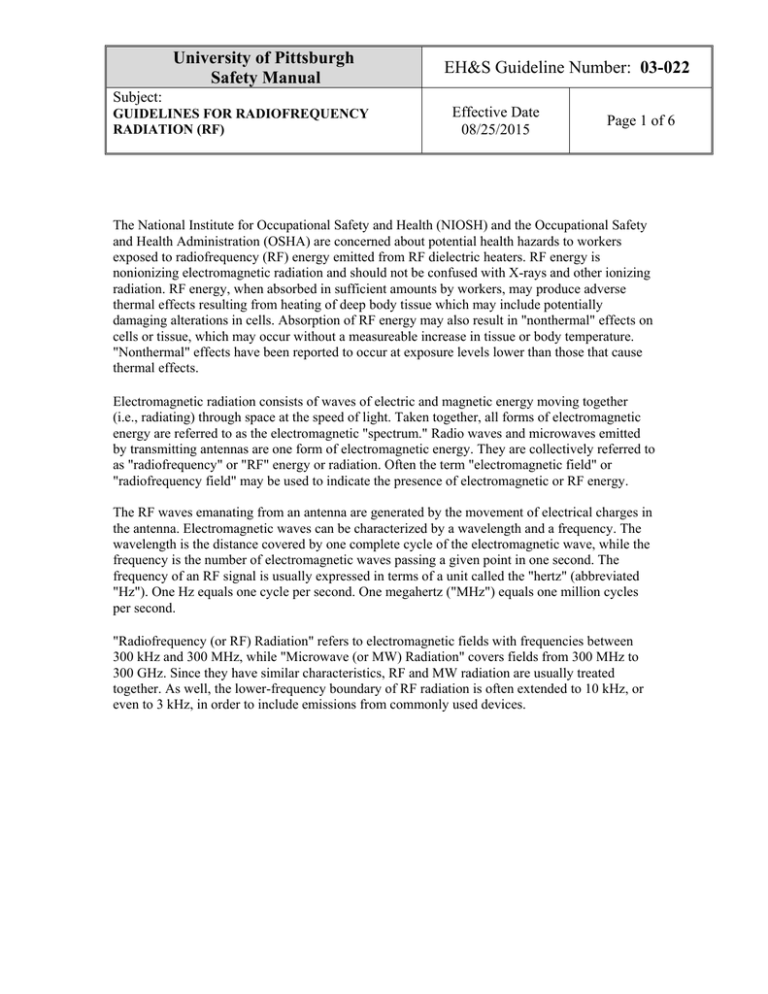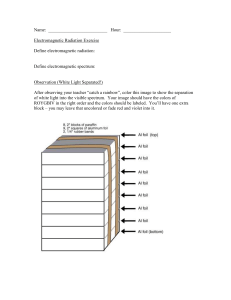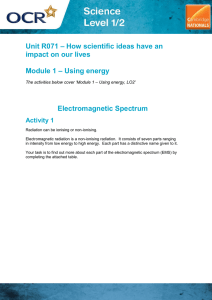Guidelines for Radiofrequency Radiation
advertisement

University of Pittsburgh Safety Manual EH&S Guideline Number: 03-022 Subject: GUIDELINES FOR RADIOFREQUENCY RADIATION (RF) Effective Date 08/25/2015 Page 1 of 6 The National Institute for Occupational Safety and Health (NIOSH) and the Occupational Safety and Health Administration (OSHA) are concerned about potential health hazards to workers exposed to radiofrequency (RF) energy emitted from RF dielectric heaters. RF energy is nonionizing electromagnetic radiation and should not be confused with X-rays and other ionizing radiation. RF energy, when absorbed in sufficient amounts by workers, may produce adverse thermal effects resulting from heating of deep body tissue which may include potentially damaging alterations in cells. Absorption of RF energy may also result in "nonthermal" effects on cells or tissue, which may occur without a measureable increase in tissue or body temperature. "Nonthermal" effects have been reported to occur at exposure levels lower than those that cause thermal effects. Electromagnetic radiation consists of waves of electric and magnetic energy moving together (i.e., radiating) through space at the speed of light. Taken together, all forms of electromagnetic energy are referred to as the electromagnetic "spectrum." Radio waves and microwaves emitted by transmitting antennas are one form of electromagnetic energy. They are collectively referred to as "radiofrequency" or "RF" energy or radiation. Often the term "electromagnetic field" or "radiofrequency field" may be used to indicate the presence of electromagnetic or RF energy. The RF waves emanating from an antenna are generated by the movement of electrical charges in the antenna. Electromagnetic waves can be characterized by a wavelength and a frequency. The wavelength is the distance covered by one complete cycle of the electromagnetic wave, while the frequency is the number of electromagnetic waves passing a given point in one second. The frequency of an RF signal is usually expressed in terms of a unit called the "hertz" (abbreviated "Hz"). One Hz equals one cycle per second. One megahertz ("MHz") equals one million cycles per second. "Radiofrequency (or RF) Radiation" refers to electromagnetic fields with frequencies between 300 kHz and 300 MHz, while "Microwave (or MW) Radiation" covers fields from 300 MHz to 300 GHz. Since they have similar characteristics, RF and MW radiation are usually treated together. As well, the lower-frequency boundary of RF radiation is often extended to 10 kHz, or even to 3 kHz, in order to include emissions from commonly used devices. University of Pittsburgh Safety Manual EH&S Guideline Number: 03-022 Subject: GUIDELINES FOR RADIOFREQUENCY RADIATION (RF) Effective Date 08/25/2015 Page 2 of 6 Electromagnetic Spectrum RF radiation is produced by devices such as radio and TV transmitters, induction heaters, and dielectric heaters. MW radiation is produced by microwave ovens, parabolic (dish) antennas, radar devices, and diathermy applicators. Federal legislation requires that microwave ovens be constructed to meet stringent microwave leakage limits and to have safety interlocks. When these interlocks are defeated, for example, during repair work, there is a risk of overexposure to microwave radiation. This guide gives advice on preventing overexposure to RF/MW radiation in the workplace. However, this guide cannot cover all possible situations. The requirements set out in the Occupational Health and Safety Act must be complied with, and they should be referred to when this guideline is used. Health Hazards The nature and the degree of the health effects of overexposure to RF/MW fields depend on the frequency and intensity of the fields, the duration of exposure, the distance from the source, and any shielding that may be used. The main effect of exposure to RF/MW fields is heating of body tissues as energy from the fields is absorbed by the body. Prolonged exposure to strong RF/MW fields may increase the body temperature, producing symptoms similar to those of physical activity. In extreme cases, or when exposed to other sources of heat at the same time, the body's cooling system may be unable to cope with the heat load, leading to heat exhaustion and heat stroke. University of Pittsburgh Safety Manual EH&S Guideline Number: 03-022 Subject: GUIDELINES FOR RADIOFREQUENCY RADIATION (RF) Effective Date 08/25/2015 Page 3 of 6 Localized heating, or "hot spots," may lead to heat damage and burns to skin and underlying tissue. Hot spots can be caused by non-uniform fields, by reflection and refraction of RF/MW fields inside the body, or by the interaction of the fields with metallic implants, for example, cardiac pacemakers or aneurism clips. There is a higher risk of heat damage to organs which have poor temperature control, such as the lens of the eye and the testes. Other hazards include contact shocks and RF burns. These can result from the electric currents which flow between a conducting object and a person who comes into contact with it while they are exposed to RF fields. (These effects should not be confused with shocks from static electricity.) Some laboratory studies have reported biological effects from RF/MW radiation at field levels which are too low to cause tissue heating. To date, these non-thermal effects are not known to result in health hazards. Although we are constantly exposed to weak RF fields from radio and television broadcasting, no health risks have been identified from this low-level exposure. Recent reports suggesting a relationship between either cellular telephone or traffic radar use and cancer have not been substantiated. Controlling RF/MW Radiation Engineering Controls Sources of RF/MW radiation should be properly shielded to minimize stray radiation. Devices which can produce acute thermal injuries (e.g., industrial MW ovens) should have interlocked doors. Devices which produce high levels of stray RF radiation (e.g., induction heaters and dielectric heaters) should be operated remotely whenever possible. Administrative Controls Exposure of workers to RF/MW Radiation should not exceed the recommended exposure limits. Potentially exposed employees should be trained on the potential health hazards and protective measures. Areas where worker exposure to RF/MW Radiation is suspected to exceed the recommended limits should be surveyed to determine the exposure levels. Needless exposure to RF/MW fields should be avoided. Exposure times should be kept as short as reasonably possible. University of Pittsburgh Safety Manual EH&S Guideline Number: 03-022 Subject: GUIDELINES FOR RADIOFREQUENCY RADIATION (RF) Effective Date 08/25/2015 Page 4 of 6 Potentially hazardous RF/MW devices should be appropriately labeled, and areas of excessive exposure around them clearly demarcated. Notices with warnings signs and the necessary precautions should be posted. Electrically-activated explosive devices should not be placed near sources of RF/MW radiation. RF/MW devices should not be used in flammable or explosive atmospheres. Equipment sensitive to RF/MW radiation, such as telephone switchboards or control panels, should not be installed near sources of RF/MW radiation. Maintenance of devices used to produce RF/MW radiation should be done by qualified personnel following standard safety procedures. The equipment should be turned off whenever possible. Personal Protection When exposures cannot be reduced by the above methods, RF/MW protective suits, including head and eye protection, can be used. Suits should be tested to ensure that they reduce worker exposure to levels below the occupational exposure limits and that they do not pose any safety hazards (e.g., overheating, shocks, or fire). Controlling RF Shocks and Burns Metallic structures producing contact shocks should be electrically grounded and/or insulated. Insulating platforms or shoes (e.g., rubber-soled shoes) can be used to reduce energy absorption and currents to ground. When the above measures are ineffective or not reasonably possible, workers should wear insulating gloves. First Aid Remove worker from exposure area to a cool environment and provide cool drinking water. Apply cold water or ice to burned areas. Seek immediate medical attention. Severe MW or RF overexposure may damage internal tissues without apparent skin injury, so a follow-up physical examination is advisable. University of Pittsburgh Safety Manual EH&S Guideline Number: 03-022 Subject: GUIDELINES FOR RADIOFREQUENCY RADIATION (RF) Effective Date 08/25/2015 Page 5 of 6 Microwave Ovens Metal reflects microwave radiation, but dry nonmetallic surfaces allow microwaves to pass through with little or no heating effect. Organic materials, however, are extremely heat conductive. Because microwaves can penetrate organic materials, including tissues, thermal burns and other effects may result from microwave exposure. NOTE: Microwave ovens are very safe when kept in good working condition and used properly. They do not serve as a source of exposure to harmful microwave radiation. Even though microwave ovens are not a source of harmful radiation exposure, they should be properly used and maintained. Do not put metal objects (including aluminum foil) into a microwave oven. Do not use a microwave oven if it is damaged. Ensure that the seal on a microwave oven is tight, intact, and in good condition (i.e., not charred or distorted). Ensure that microwave ovens are clearly labeled for laboratory use or food preparation only. Microwave ovens should only be repaired by trained personnel. Exposure Limits The International Council on Non-Ionizing Radiation Protection (ICNIRP) guidelines provide a two-tier set of RF exposure limits. The ICNIRP standard is used in most European countries and is gaining acceptance in many other countries outside of North America. The ICNIRP guidelines have exposure limits for electric fields and magnetic fields that are whole-body and time averaged. The higher tier is referred to as “Occupational” (Table 1) while the more restrictive tier is referred to as “General Population.”(Table 2) The limits for the electric and magnetic field are very similar to the limits in the 1997 FCC Regulations. The differences occur in the two transition regions: between 1 and 30 MHz and between 300 and 2,000 MHz. At the lower frequency transition, Safety Code 6 and the ICNIRP standard have variable limits from 1 to 10 MHz. All the U.S. standards (IEEE, ANSI, FCC, ACGIH, and DOD) plus the NATO standard have variable limits from 3 to 30 MHz. And while all the North American standards have variable limits from 300 to 1,500 or 3,000 MHz—depending on the limits in the microwave region—the ICNIRP standard has variable limits from 400 to 2,000 MHz. Exposure limits are given from DC to 300 GHz. Exposure limits for the magnetic (H) field are relaxed below 100 MHz since the exposure limits at lower frequencies are based more on electrostimulation than body heating, and both induced and contact currents are related to the strength of the electric field. There are also limits for induced currents and contact currents. University of Pittsburgh Safety Manual EH&S Guideline Number: 03-022 Subject: Effective Date 08/25/2015 GUIDELINES FOR RADIOFREQUENCY RADIATION (RF) Page 6 of 6 Electric Field Limits Exposure limits for the electric field are shown in the two tables below. The tables do not include the limits below 65 kHz. Reference Levels for Occupational Exposure Electric Field Power Density Frequency (MHz) (V/m) (W/m²) 0.065–1.0 610 1.0–10.0 610/f 10–400 61 400–2,000 10 f/40 2,000–300,000 Table 1 50 Reference Levels for General Public Exposure Electric Field Power Density Frequency (MHz) (V/m) (mW/cm²) 0.15–1.0 610 1.0–10.0 87/f½ 10–400 28 400–2,000 2,000–300,000 Table 2 2.0 f/200 10 Other Limits The limits for the magnetic field are higher below 1.0 MHz. There are also exposure limits for induced and contact currents.



